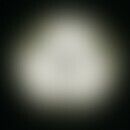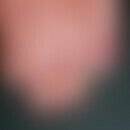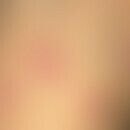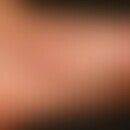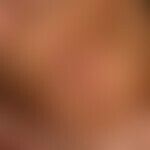Synonym(s)
HistoryThis section has been translated automatically.
Staphan Antiochus (quoted n. Kaposi 1883 in Lehrbuch Pathologie und Therapie der Hautkrankheiten)
DefinitionThis section has been translated automatically.
Tinea is an infection of the stratum corneum of the epidermis, hair and/or nails caused by dermatophytes.
The name is borrowed from Latin (tinea = moth, woodworm).
Dermatophytes are able to break down keratin by splitting disulphide bridges, which explains their marked preference for keratin-containing substrates. Even in tinea profunda with deep infestation of the hair follicles, the pathogens do not penetrate the dermis. By adding the respective body region, e.g. tinea inguinalis, tinea barbae, traditionally anchored terms such as kerion celsi, eccema marginatum, etc. are no longer necessary. The uniformity of the "tinea term" is jeopardized by misleading terms such as tinea amiantacea for pityriasis amiantacea and tinea versicolor for pityriasis versicolor.
The targeted treatment of tinea requires an exact diagnosis by detecting the pathogens in the native preparation, by culture or PCR techniques.
You might also be interested in
PathogenThis section has been translated automatically.
Dermatophytes. The dermatophytes include the genera Trichophyton, Epidermophyton and Mikrosporum. A classification into geophilic, zoophilic and anthropophilic species is useful for epidemiological as well as clinical reasons. Geophilic and zoophilic dermatophytes cause significantly more inflammatory foci in humans than anthropophilic dermatophytes, whereas they can be present in animals almost asymptomatically. The following dermatophytes are relevant in dermatology:
- Anthropophilic species: T. rubrum, Epidermophyton floccosum, M. audouinii, T. schönleinii, T. soudanense, T. violaceum, T. tonsurans
- Zoophilic species: T. mentagrophytes, M. canis, T. verrucosum.
- Geophilic species: M. gypseum.
ClassificationThis section has been translated automatically.
The clinical picture of dermatophyte infection varies and is essentially defined by the topography:
I. Head:
II. strain:
-
Tinea corporis:
- Steroid modified tinea
- Tinea imbricata
- Tinea inguinalis
III Extremities:
- Tinea manuum
- Tinea pedum
- Tinea unguium(onychomycosis)
- Tinea cruris
- Tinea nigra
- Mycetoma.
Occurrence/EpidemiologyThis section has been translated automatically.
Dermatophytes as pathogens of tinea are represented worldwide with varying incidence and prevalence. The incidence of dermatomycoses depends primarily on local factors such as outside temperatures, skin penetration and individual susceptibility. The prevalence of tinea pedis in certain cohorts (e.g. soldiers) is between 10 and 15%. In larger collectives with dermatomycoses, onychomycosis and tinea pedis are the most common (Hansen I et al. 2021).
ClinicThis section has been translated automatically.
DiagnosisThis section has been translated automatically.
- infestation of hair follicles and/or nails
- Persistent hyper- or hypopigmentation
- Secondary bacterial overlaps
- Secondary contact allergy
- Surgical pretreatments (incisions)
- Pretreatment with corticosteroids
- Intertriginous maceration.
- See Table 1, see mycoses below.
General therapyThis section has been translated automatically.
External therapyThis section has been translated automatically.
External monotherapy is generally considered sufficient for the following types of dermatophytosis: non-inflammatory tinea corporis, tinea faciei, tinea manuum et pedum. The external antifungal agents listed below have been most widely used with comparable quality and efficacy:
- Imidazole derivatives: clotrimazole (e.g., R055 R056, Canesten cream, Clotri OPT, Cutistad), econazole (e.g., Epi-Pevaryl cream), ketoconazole (e.g., Nizoral cream), miconazole (e.g.E.g., R173 , R172 Daktar solution, Vobamyk, Micotar), bifonazole (e.g., Mycospor), oxiconazole (e.g., Myfungar cream), tioconazole (e.g., Mykontral), fenticonazole (e.g., Lomexin).
- Allylamines: naftifine (e.g. Exoderil cream), terbinafine (e.g. Lamisil solution seems to have some superiority in practical use over imidazole preparations, since a single therapy - "Lamisil Once" - is effective for tinea pedis).
- Morpholine: Amorolfine (Loceryl cream)
- Ciclopiroxolamine (e.g. Batrafen cream)
- Sertaconazole nitrate (e.g. Zalain, Mykosert).
- Various: tolnaftate (e.g. Tonoftal cream), dyes (e.g. eosin or methylrosanilinium chloride).
- Combination preparations with glucocorticoids, disinfectants or antibiotics. Although these combinations are valued as "antidote" preparations, they should be used only in exceptional cases. In inflammatory accentuated pruritic dermatomycoses, glucocorticoid-containing monotherapeutics can be used passively.
In case of therapy resistance, see also Photodynamic therapy, Indication.
Internal therapyThis section has been translated automatically.
Indication for systemic therapy is given in the following diseases:
- Inflammatory accentuated dermatomycoses
- Hyperkeratotic tinea of the palms and soles of the feet
- Extensive tinea
- Tinea capitis
- Granulomatous or nodular tinea
- Immunocompromised patients
- Tinea unguium of several toes or fingers
- Therapy resistance or intolerance to external antimycotics.
The following preparations have found the widest distribution with comparable quality and effect: griseofulvin (e.g. Likuden M), itraconazole (e.g. Sempera), fluconazole (e.g. Diflucan), terbinafine (e.g. Lamisil).
Operative therapieThis section has been translated automatically.
ProphylaxisThis section has been translated automatically.
NaturopathyThis section has been translated automatically.
There are a number of natural remedies for which antifungal efficacy has been demonstrated in various study designs. Study designs antifungal efficacy have been demonstrated. These include tea tree oil (in 25% and 50% application form), Solanum chrysotrichum (Mexican tomato) in a cream application, Eucalytus pauciflora 1% oil ( eucalyptus oil with the active ingredient cineol) and Ajone, the ingredient of Allium sativum in a 0.4% cream application.
TablesThis section has been translated automatically.
Diagnostic criteria for tinea
Medical history |
General diseases |
Chronic liver diseases |
Chronic kidney diseases | ||
Endocrinological diseases (e.g. diabetes mellitus) | ||
Peripheral circulatory disorders (Tinea unguium) | ||
Pretreatment |
External pre-therapies (especially pre-treatment with glucocorticoids) |
|
System Therapies | ||
other skin diseases |
especially atopy or contact sensitization |
|
Profession |
Lifeguard or similar |
|
Agriculture | ||
Veterinary professions | ||
Leisure contacts |
Garden |
|
Sports activities with use of common cleaning areas in showers or sauna | ||
Animal contacts | ||
| ||
Studies |
General physical examination |
|
Localization of the skin changes | ||
Extent of the lesions | ||
Type of lesion |
Non-inflammatory, scaling, chronic |
|
Acute or subacute, eczematous, itching | ||
Chronically lichenified | ||
Follicular papules or nodules (abscess) | ||
Vesicular or bullous (Id reaction) | ||
Pustular, similar to pyoderma | ||
Note(s)This section has been translated automatically.
Billing tips:
- Taking of the smear: The taking of the smear is to be carried out according to the No. 298 GOÄ (also several times, in case of taking of different smears). Body parts and separate preparation). In the case of complex nail collection, the No. 743 GOÄ (analogous) can be applied.
- Microscopy: In case of microscopic fungus detection with addition of potassium hydroxide solution, No. 4711 GOÄ can be used. Simple staining with methylene blue is accounted for with No. 3509 GOÄ (per preparation).
- Culture: A Sabouraud agar (simple culture medium) is charged with No. 4715 GOÄ up to 5 times from the same medium. If special culture media (complex culture medium) are used, the number 4716 GOÄ or the No. 4717 (differentiation medium) must be used.
- Light microscopic examination of cultivated fungi: No. 4722 GOÄ.
LiteratureThis section has been translated automatically.
- Brasch J (1990) Pathogens and pathogenesis of dermatophytoses. Dermatologist 41: 9-15
- Choi E et al. (2018) Pustular tinea manuum from Trichophyton erinacei infection. JAAD Case Rep. 4:518-520.
- Drake LA et al. (1996) Guidelines of care for superficial mycotic infection of the skin: Tinea corporis, tinea cruris, tinea faciei, tinea manuum tinea pedis. J Am Acad Dermatol 34: 282-286
- Effendy I (2003) Nail changes during childhood. Dermatologist 54: 41-44
- Gupta AK et al. (2003) Superficial fungal infections: an update on pityriasis versicolor, seborrheic dermatitis, tinea capitis, and onychomycosis. Clin Dermatol 21: 417-425
- Hansen I et al. (2024) Epidemiology of skin diseases in Germany: systematic literature review of the current state of research - Part 3: infectious skin diseases. JDDG 20: 589-596
- Ilkit M et al.(2014) Tinea pedis: the etiology and global epidemiology of a common fungal infection. Crit Rev Microbiol 41:374-388
- Leibovici V et al. (2014) Prevalence of tinea pedis in psoriasis, compared to atopic dermatitis and normal controls--a prospective study. Mycoses 57:754-758
- Müller VL et al. (2021) Tinea capitis et barbae caused by Trichophyton tonsurans: A retrospective cohort study of an infection chain after shavings in barber stores. Mycoses 64:428-436.
- Nenoff P et al. (2014) Mycology-an update part 2: Dermatomycoses: Clinical picture and diagnosis. JJDG 12: 749-778
- Seebacher C (2003) The change of dermatophyte spectrum in dermatomycoses. Mycoses 46(Suppl1): 42-46
- Seebacher C et al. (2006) Tinea capitis. J Dtsch Dermatol Ges 4: 1085-1091
Uhrlass S et al. (2022) Trichophyton indotineae-An Emerging Pathogen Causing Recalcitrant Dermatophytoses in India and Worldwide-A Multidimensional Perspective. J Fungi (Basel) 8:757.
Incoming links (67)
Acrocyanosis; Benhamiae trichophyton; Bowen's disease; Clotrimazole ointment hydrophilic 2% (nrf 11.50.); Clotrimazole solution hydrophile 1% (nrf 11.40.); Demodex folliculitis; Dermatitis; Dermatomycoses; Dermatophyte infections; Dermatophytosis; ... Show allOutgoing links (62)
Acute paronychia; Amorolfin; Antibiotics; Antimycotics; Candida paronychia; Chronic mucocutaneous candidiasis; Ciclopirox; Clotrimazole; Clotrimazole ointment hydrophilic 2% (nrf 11.50.); Clotrimazole solution hydrophile 1% (nrf 11.40.); ... Show allDisclaimer
Please ask your physician for a reliable diagnosis. This website is only meant as a reference.

